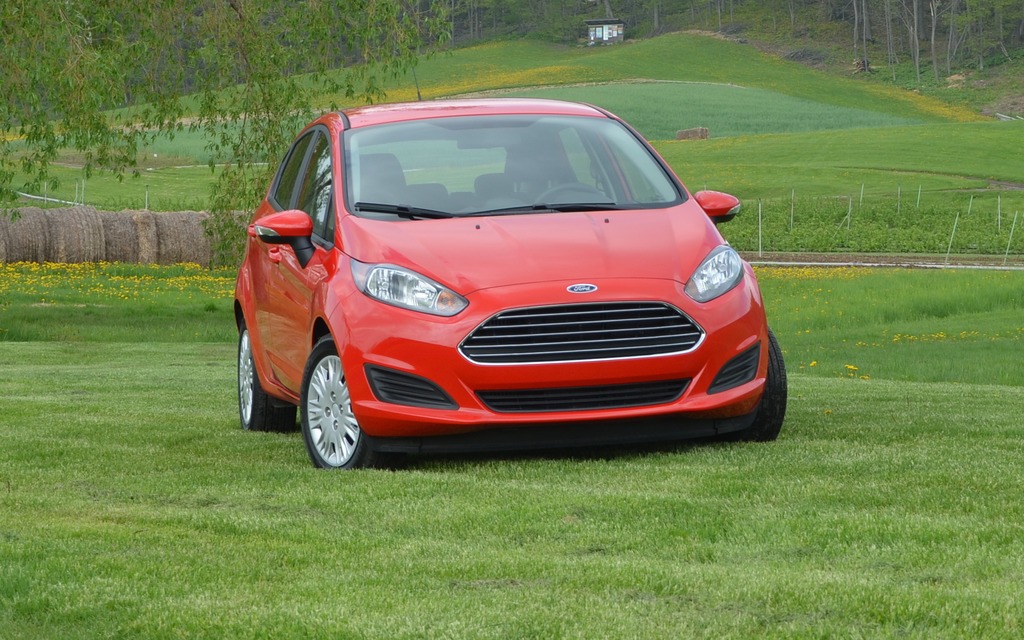2014 Ford Fiesta One-Litre: Underhood Ménage-A-Trois

| Strong points |
|
|---|---|
| Weak points |
|
Ford has a tendency to go for extremes. Take, for example, the F-150’s extreme sales figures or the E-Series’ extreme longevity. Then there’s the Mustang V6’s 300 horsepower, which is pretty extreme for a base model. But drawing 123 horses and 148 lbs.-ft. of torque from a 1.0-litre three-cylinder engine is extreme too!
Just a few days ago, Ford invited us to try the 1.0-litre EcoBoost Fiesta, a car that many journalists had the chance to try during the Los Angeles Auto Show last September. At the time, we expected the 2014 Fiesta 1.0 to arrive in Canada in 2013, but in the end we’ve waited several months longer—just to get the 2014 model. But not to worry, the 2015 model is on its way.
- Also: A Ford Fusion on a Diet
- Also: Ford Takes Asia by Storm
Small but strong
The diminutive engine (whose block can fit in your carry-on bag!) started its career in a European Focus. This mill benefits from Ford’s EcoBoost technology, which includes a turbocharger, direct fuel injection and variable valve timing. Its block is made of steel, which is heavier than aluminium but has the advantage of attaining its working temperature more quickly. And even though the engine has an uneven number of cylinders—and thus is more sensitive to vibrations—the engineers decided against including balance shafts. Instead, there are an adapted crankshaft pulley and engine supports. Another one of the engine’s unique features is the internal timing belt, which is bathed in engine oil to reduce noise. According to Ford, this belt will never require maintenance.
On paper, it all sounds good. But what’s this engine like in a Fiesta? First, we should mention that this engine can currently only be paired with a five-speed manual transmission. However, a little bird told me that a six-speed dual-clutch transmission may be on offer for 2015. (Hint: It’s already available in Europe!) But let’s get back to the test drive. Just a few metres into the drive and we noticed that the three-cylinder engine was very quiet and smooth. We were especially surprised by the lack of delay for the turbo to kick in, as well as the lack of vibration, even at low speeds. It lacks a bit of power under 3,000 rpm, like all small engines do, but the generous torque affords good pick-up. I wasn’t able to test its acceleration, but I got the impression that the 0-100 km/h sprint would take about 9.0 seconds and that going from 80-120 in fourth gear would take about 7.0 seconds. The manual gearbox does a decent job. Its clutch is appropriately calibrated and gears are well spaced.
What about fuel economy?
Ford claims that its 1.0-litre Fiesta consumes 6.2 litres per 100 km in the city and 4.3 on the highway (using the old two-cycle system). While these numbers were undoubtedly the result of extensive effort and scientific precision, I doubt that the average driver could attain them. During our test drive on country roads and highways, I calculated an average of 5.7 L/100 km. Had my partner and I been a little less enthusiastic with the accelerator, we could have easily gotten 5.3. Regardless, the Fiesta 1.0’s fuel economy is very good, especially when you consider its engine output.
The 1.0-litre EcoBoost engine is offered as on option, and only in the SE version of the Fiesta (sedan or hatchback). This vehicle bears the SFE badge on its trunk (with “F” standing for “fuel”). This option costs $1,295 but saves you at least one litre of gas for every 100 km. Plus, it offers you a superior ride compared to the regular version and its 1.6-litre four-cylinder engine. It’s well worth the price for that reason alone. Meanwhile, the interior is exactly the same as the one in the Fiesta SE!











